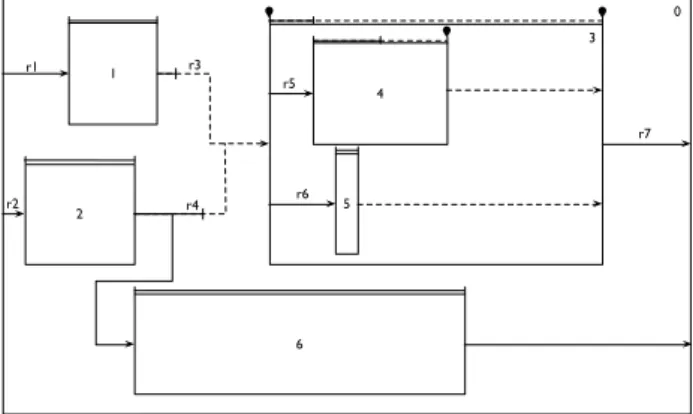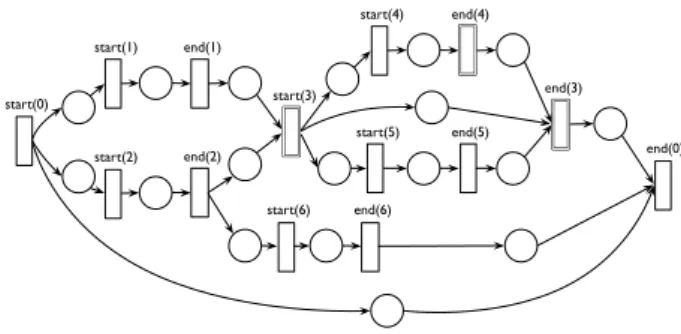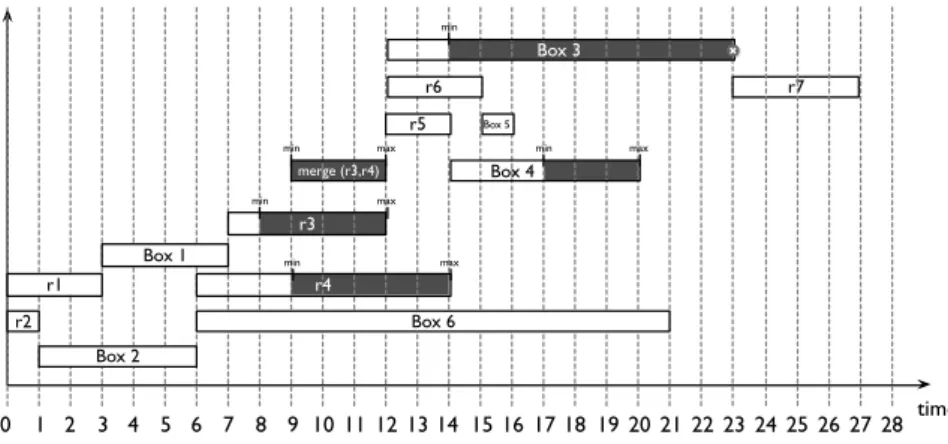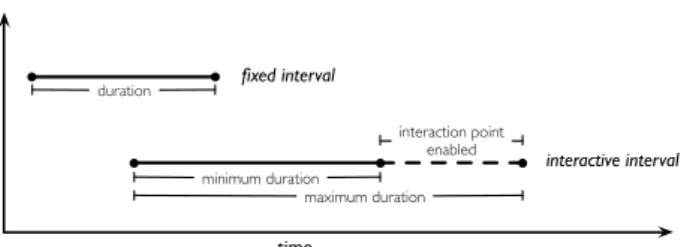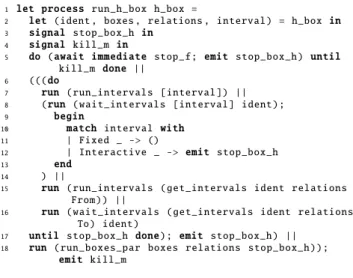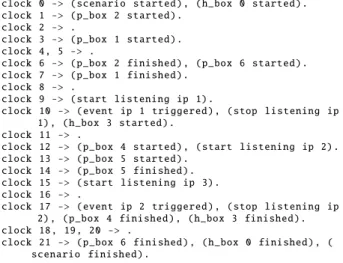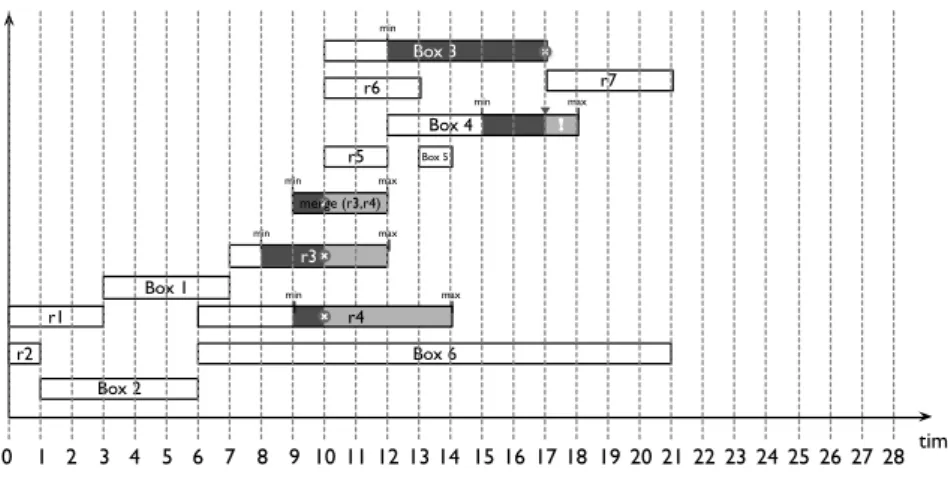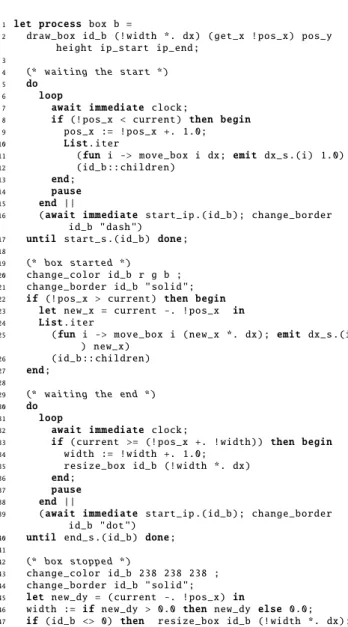HAL Id: hal-01095159
https://hal.archives-ouvertes.fr/hal-01095159
Submitted on 22 Sep 2015
HAL is a multi-disciplinary open access
archive for the deposit and dissemination of
sci-entific research documents, whether they are
pub-lished or not. The documents may come from
teaching and research institutions in France or
abroad, or from public or private research centers.
L’archive ouverte pluridisciplinaire HAL, est
destinée au dépôt et à la diffusion de documents
scientifiques de niveau recherche, publiés ou non,
émanant des établissements d’enseignement et de
recherche français ou étrangers, des laboratoires
publics ou privés.
Executing Hierarchical Interactive Scores in ReactiveML
Jaime Arias, Myriam Desainte-Catherine, Sylvain Salvati, Camilo Rueda
To cite this version:
Jaime Arias, Myriam Desainte-Catherine, Sylvain Salvati, Camilo Rueda. Executing Hierarchical
Interactive Scores in ReactiveML. Journées d’Informatique Musicale 2014, May 2014, Bourges, France.
�hal-01095159�
EXECUTING HIERARCHICAL INTERACTIVE SCORES IN
REACTIVEML
Jaime Arias, Myriam Desainte-Catherine, Sylvain Salvati
Univ. Bordeaux, LaBRI, Bordeaux, F-33000, France
CNRS, UMR 5800, Bordeaux, F-33000, France
IPB, LaBRI, Bordeaux, F-33000, France
{jaime.arias, myriam, sylvain.salvati}@labri.fr
Camilo Rueda
Departamento de Electrónica y
Ciencias de la Computación
Pontificia Universidad Javeriana
Cali, Colombia
crueda@javerianacali.edu.co
RÉSUMÉ
Le modèle des partitions interactives permet d’écrire et d’exécuter des scénarios multimédia interactifs. Le logi-ciel I-SCORE implémente ce modèle au moyen des Hi-erarchical Time Stream Petri Nets (HTSPN). Cependant, cette implémentation est très statique et l’ajout de cer-taines fonctionnalités peut nécessiter une reconception com-plète du réseau. Un autre problème deI-SCOREest qu’il ne fournit pas un bon retour visuel de l’exécution d’un scénario. Dans cet article, nous définissons et implémen-tons un interprète de partitions interactives avec le lan-gage de programmation synchrone REACTIVEML. Dans ce travail, nous tirons parti de l’expressivité du modèle réactif et de la puissance de la programmation fonction-nelle pour obtenir un interprète plus simple et plus dy-namique. Contrairement à l’implémentation basée sur les réseaux de Petri, cette approche permet de définir précisé-ment l’aspect hiérarchique et permet de prototyper facile-ment de nouvelles fonctionnalités. Nous proposons aussi une visualisation temps réel de l’exécution en utilisant l’environnement INSCORE.
ABSTRACT
Interactive scores proposes a model to write and execute interactive multimedia scores. The software I-SCORE im-plements the above model using Hierarchical Time Stream Petri Nets (HTSPN). However, this model is very static and modelling new features would require a complete re-design of the network or sometimes they cannot be ex-pressed. Another problem ofI-SCOREis that it does not provide a good visual feedback of the execution of the scenario. In this work, we define and implement an in-terpreter of interactive scores using the synchronous pro-gramming language REACTIVEML. Our work takes ad-vantage of the expressiveness of the reactive model and the power of functional programming to develop an in-terpreter more dynamic and simple. Contrary to the Petri Net model, our approach allows to model precisely the hi-erarchical behaviour, and permits the easy prototyping of new features. We also propose a visualization system us-ing the environment INSCORE that provides a real-time
visualization of the execution of the score.
1. INTRODUCTION
Interactive scores [10] proposes a model to write and exe-cute interactive scenarios composed of several multimedia processes. In this model, the temporal organization of the scenario is described by means of flexible and fixed tem-poral relations among temtem-poral objects (i.e., multimedia processes) that are preserved during the writing and per-formance stage.
The implementation of interactive scores in the soft-ware I-SCORE1 is based on Petri Nets [17]. Such im-plementation provides an efficient and safe execution, but implies a quite static structure. Indeed, only elements that have been planned during the composition process can be executed. Therefore, it is not possible to modify the structure of the scenario during execution, for example, dynamically add a new element that was not written be-fore execution. In addition, modelling new features for
I-SCOREsuch as conditionals, loops or handling streams would require a complete redesign of the network. There-fore, this model is not suitable for compositional develop-ment and integration of new features that composers in-creasingly need to write more complex scenarios.
In this paper, we explore a new way to define and im-plement interactive scores, aiming at a more dynamic model. For this purpose, we use REACTIVEML [16], a program-ming language for implementing interactive systems (e.g., video games and graphical user interfaces). This language is based on the synchronous reactive model of Boussinot [8], then it provides a global discrete model of time, clear se-mantics, and unlike Petri nets, synchronous and determin-istic parallel composition and features such as dynamic creation of processes. Moreover, REACTIVEML has been previously used in music applications [4, 5] showing to be very expressive, efficient, capable of interacting with the environment during the performance of complex scores, and well suited for building prototypes easily.
The rest of the paper is organized as follows. In Section 2 we present theI-SCOREsystem and we briefly introduce
the REACTIVEML programming language. In Section 3 we describe the implementation in REACTIVEML of the new interpreter of interactive scores. Next, in Section 4 we present the improved visualization system in INSCORE. Finally, in Section 5 we present related work, conclusions, and ideas for future work.
2. PRELIMINARIES
In this section we present theI-SCOREsystem and the nec-essary notions of REACTIVEML language.
2.1. I-SCORE
I-SCORE[3, 17] is a software for composing and execut-ing interactive multimedia scenarios [2]. It consists of two sides: authoring and performance. In the authoring side, the composer designs the multimedia scenario while in the performance side the performer executes the scenario with interactive capabilities. Next, we present in more detail both sides.
2.1.1. Authoring side
In interactive scores [10], multimedia elements are tem-poral structures represented as boxes. These boxes can be either simple or complex. A simple box represents a mul-timedia process that will be executed by an external appli-cation such as PUREDATA2 or MAX/MSP3. I-SCORE
controls such applications by means of OSC4 messages.
On the other hand, a complex box allows to gather and execute a set of boxes making possible the design of large and complex scenarios. However, this box does not exe-cute a multimedia process.
The temporal organization of the score is partially de-fined by temporal relations. They indicate a precedence relation between boxes using Allen’s relations [1], as well as a delay between them. A temporal relation can be ei-ther rigid or flexible. In a rigid relation, the duration of the delay is fixed whereas in a flexible relation, the dura-tion is partially defined by an interval of time (i.e., it has a minimum and a maximum duration).
The composer can add interaction points to boxes. They allow to modify the preceding relations (i.e., start date) and the duration (i.e., end date) of boxes during the exe-cution. In the case of a complex box, an interaction point stops abruptly the box with its children. It is important to know that the temporal organization of the score is pre-served during composition and performance. Therefore, the performer can interpret the same score in different ways within the constraints of the composer. In I-SCORE, an interaction point is triggered by sending the OSC mes-sage defined by the composer. Additionally, all preceding relations of a box with an interaction point are flexible, otherwise they are rigid.
2http://puredata.info
3http://cycling74.com/products/max/
4http://opensoundcontrol.org/introduction-osc
In Figure 1 we illustrate an interactive scenario with all its temporal relations. Here, the horizontal axis represents time and the vertical axis has no meaning. Additionally, the start and end of boxes are partially defined by tempo-ral relations that are represented as solid (rigid relation) and dashed (flexible relation) arrows. Moreover, tabs rep-resent the interactions points of boxes.
2 4 3 5 1 6 0 r2 r1 r3 r4 r5 r6 r7
Figure 1. Example of an interactive scenario.
2.1.2. Performance side
In order to execute the scenario designed in the previ-ous side, I-SCOREtranslates the score into a Hierarchical Time Stream Petri Net (HTSPN) [19]. The Petri net model allows to trigger the interactive events, and also it denotes and preserves the temporal organization of the score dur-ing the execution. The reader may refer to [17] for further information on generating the HTSPN structure from the score. The following example illustrates the execution of a scenario.
Example 1. Consider the interactive score in Figure 1 with the following configuration :
• Box 1 starts 3 seconds after the start of the scenario. Its duration is 4 seconds.
• Box 2 starts 1 second after the start of the scenario. Its duration is 5 seconds.
• Box 6 starts immediately (i.e., 0 seconds) after the end of the box 2. Its duration is 15 seconds. • Box 3 is a complex box with two children; the box
4 and 5. The start of the box is defined by the flex-ible relations r3 and r4 whose durations are [1, 4] and [3, 8], respectively. Therefore, at any instant in which the above relations are satisfied, the box may be started by triggering the interaction point. In Section 3 we elaborate more on the semantics of temporal relations and interaction points.
• The duration of the box 3 is the interval [2, ∞], then the box may be stopped after 2 seconds of its start-ing by triggerstart-ing the interaction point.
• Box 4 starts 2 seconds after the start of its parent (i.e., box 3). Its duration is the interval [3, 6], then the box may be stopped after 3 seconds of its start-ing by triggerstart-ing the interaction point. It is impor-tant to know that the box will stop when it reaches its maximum duration (i.e., 6 seconds) if the inter-action point is not triggered before.
• Box 5 starts 3 seconds after the start of the box 3. Its duration is 1 second.
• The scenario finishes when the box 6 finishes and 4 seconds have elapsed after the end of the box 3. Following [17], we translated the score into its equiva-lent HTSPN structure (Figure 2). For the sake of simplic-ity, we do not show the time interval on the arcs. Note that transitions with double stroke are those with an interaction point. start(0) start(1) start(2) end(2) end(1) start(3) start(6) end(6) start(4) start(5) end(4) end(5) end(3) end(0)
Figure 2. HTSPN structure of the scenario specified in Example 1.
We show in Figure 4 an execution of the above scenario where only the interaction point of the box 3 is triggered. All other intervals reach their maximum duration. Note that box 3 must be stopped, otherwise it will never end because it has an infinite duration. merge(r3,r4) repre-sents the interval of time in which the box 3 may start. In this interval, the relations r3 and r4 are satisfied. As can be seen, the interaction point is not triggered, then the box starts when the interval reachs its maximum duration. We can conclude that this scenario finishes in 27 seconds only if the interaction point at the end of the box 3 is triggered at 23 seconds.
2.2. REACTIVEML
REACTIVEML [16] is a synchronous reactive program-ming language designed to implement interactive systems such as graphical user interfaces and video games. It is based on the reactive model of Boussinot [8] and it is built as an extension of the functional programming lan-guage OCAML5. Therefore, it combines the power of functional programming with the expressiveness of syn-chronous paradigm [6].
The reactive synchronous model provides the notion of a global logical time. Then, time is viewed as a sequence
5http://ocaml.org
of logical instants. Additionally, parallel processes are ex-ecuted synchronously (lock step) and they communicate with each other in zero time. This communication is made by broadcasting signals that are characterized by a status defined at every logical instance: present or absent. In contrast to ESTEREL[7], the reaction to absence of sig-nals is delayed, then the programs are causal by construc-tion (i.e., a signal cannot be present and absent during the same instant). Moreover, the reactive model provides dy-namic features such as dydy-namic creation of processes. In-deed, REACTIVEML provides a toplevel [15] to dynami-cally write, load and execute programs.
In REACTIVEML, regular OCAML functions are stantaneous (i.e., the output is returned in the same in-stant) whereas processes (processkeyword) can be exe-cuted through several instants. Next, we use the program shown in Figure 3 to describe the basic expressions of RE
-ACTIVEML.
1 let process killable_p p s =
2 do
3 run p
4 until s done
5
6 let process wait tic dur =
7 for i=1 to dur do await tic done
8
9 let process emit_tic period tic =
10 let start = Unix . gettimeofday () in
11 let next = ref ( start +. period ) in
12 loop
13 let current = Unix . gettimeofday () in
14 if ( current >= ! next ) then begin
15 emit tic ();
16 next := ! next +. period
17 end ;
18 pause
19 end
Figure 3. Example of REACTIVEML language.
Two expressions can be evaluated in sequence (e1;e2) or in parallel (e1||e2). In REACTIVEML is possible to write higher order processes like the processkillable_p
(line 1) which takes two arguments: a processp and a signals. This process executespuntilsis present. The expressionrunexecutes a process (line 3). There are two important control structures: the constructiondo e until s to interrupt the execution of e when the signal s is present, and the constructiondo e when sto suspend the execution ofewhen the signalsis absent.
Signals can be emitted (emit), and awaited (await). For instance, the process wait (line 6) takes two argu-ments: a signal ticand an integerdur. The purpose of this process is similar to a timer; it waits for the signal
ticto be emitted a numberdurof times. The expression
await swaits forsto be emitted and it finishes in the next
instant whereas the expressionawait immediate swaits forsto be emitted and it terminates instantaneously. An important characteristic of the REACTIVEML implemen-tation is the absence of busy waiting: nothing is computed when no signal is present. The processemit_tic(line 9) takes two arguments: a floatperiodand a signaltic. It works like a clock; it gets the current time by using the
time 0 1 2 3 4 5 6 7 8 9 10 11 12 13 14 15 16 17 18 19 20 21 22 23 r1 r2 Box 1 Box 2 Box 6 min max r4 r3 min max max min merge (r3,r4) r5 r6 Box 5 Box 4 min max Box 3 min r7 24 25 26 27 28
Figure 4. Execution of Example 1 where only the interaction point of the box 3 is triggered.
functionUnix.gettimeofdayfrom theUnixmodule, and emits the signaltic(line 15) whenever the period of time expires (line 14). Thepause(line 18) keyword awaits for the next instant. The constructionloop e enditerates in-finitelye.
REACTIVEML also provides valued signals. They can be emitted (emit s value) and awaited to get the associ-ated value (await s (pattern)in expression). Differ-ent values can be emitted during an instant (multi-emission). In this case, it is necessary to define how the emitted val-ues will be combined during the same instant (signal
name default value gather function in expression).
The value obtained is available at the following instant in order to avoid causality problems. For example, the pro-cessadd(Figure 5) declares the local signalnum(line 2) with an initial value0and a function which adds two in-tegers. The processgen(line 3) generates a set of values that are emitted through the signalnumat the same instant. The processprint(line 6) awaits for the signalnum, and then it prints the value inn. Note thatncontains the sum of all values generated by the processgen.
1 let process add max =
2 signal num default 0 gather fun x y -> x+y in
3 let process gen =
4 ( for i =1 to max do emit num i done )
5 in
6 let process print =
7 await num (n) in
8 print_endline ( string_of_int n)
9 in
10 run gen || run print
Figure 5. Example of multi-emission of signals.
3. SYNCHRONOUS MODEL OF INTERACTIVE SCORES
In this section, we present a new execution model of in-teractive scores using the reactive programming language REACTIVEML. The implementation of the interpreter is divided into two main modules: Time and Motor. The module Time interfaces the abstract time relative to the
tempo (in beats) and the physical time (in ms). This ule is based on the work of Baudart et al. [4, 5]. The
mod-uleMotorinterprets the interactive score and interacts with
the environment by listening external events and trigger-ing external multimedia processes. The implementation fulfills the operational semantics of interactive scores [10]. In the following, we describe the above modules.
3.1. Modelling Time
REACTIVEML, like other synchronous languages, pro-vides the notion of a global logical time. Then, time is viewed as a sequence of logical instants. The process
emit_tic (Figure 3), explained in Section 2.2, is the
in-terface between the physical time and the logical time. Its purpose is to generate the clock of the system by emitting a signal in a periodic time. Therefore, from this signal of clock, we can define a process to express delays by wait-ing a specific number of ticks (processwaitin Figure 3).
3.2. Execution of Interactive Scores
Interactive scores [10] are basically composed of: boxes that represent multimedia processes; temporal relations that define the temporal organization of the score (i.e., the start and the end of boxes); and interaction points that transform a static score into dynamic by allowing the per-former to modify the temporal relations during the execu-tion. In the following, we present the implementation of the above elements in REACTIVEML.
3.2.1. Temporal relations
Temporal relations partially define the temporal organiza-tion of the scenario. They represent delays that allow to specify the start and the duration of boxes. Relations can be either rigid or flexible. In a rigid relation, the duration of the delay is fixed whereas in a flexible relation, the du-ration of the delay is partially defined by an interval of time. This interval can be modified by triggering an inter-action pointduring the execution.
Hence, we define two types of intervals in order to rep-resent temporal relations. The fixed interval reprep-resents a rigid relation and the interactive interval represents a flex-ible relation with an attached interaction point (Figure 6). The interaction point allows to stop the interval during the defined interval of time (i.e., between the minimum and the maximum duration) by triggering a specific event.
time fixed interval interactive interval duration minimum duration maximum duration interaction point enabled
Figure 6. Fixed and flexible intervals.
In REACTIVEML, we represent a fixed interval as a
tu-ple(d,s)where the signalsis emitted when the duration
dhas elapsed. On the other hand, the interactive interval is defined as a tuple(min,max,ip)whereminandmaxare fixed intervals that represent the minimum and maximum duration of the interval, andipis its interaction point. It should be noted that the duration of a flexible interval can be either finite or infinite.
Interaction points are represented as OSC messages that are sent from the environment and transmitted through a signal. An OSC message is represented as a tuple(t, a)wheretis the address anda is the list of arguments with their type. For example, (‘/light/1’, [String ‘
luminosity’; Int32 90]).
Hence, we define a temporal relation between two boxes as a tuple(from,to,intrvl)wherefrom andto are the identifiers of the boxes involved in the relation, andintrvl
is the interval that defines the delay between them.
3.2.2. Boxes
Boxes can be either simple or complex. A simple box rep-resents a multimedia process that is executed by an exter-nal application. For this reason, the interpreter only sends OSC messages in order to control its start and end. On the other hand, a complex box gather and execute a set of boxes with their own temporal organization. Recall that the duration of a box is defined by an interval. Then, it can be either fixed or interactive. In the rest of the paper, we call rigid boxes as process boxes and complex boxes as hierarchical boxes.
A process box is defined as a tuple(id,intrvl,s_msg
,e_msg)where: idis the identifier of the box;intrvlis
the interval that defines its duration;s_msgande_msgare the OSC messages to start and stop the external process, respectively. We define a hierarchical box as a tuple(id,
b_list, r_list, intrvl)where:idis the identifier of
the box;b_listis the list of its children;r_listis the list of the relations; andintrvlis the interval that defines its
duration. The following example illustrates the represen-tation of boxes and relations in REACTIVEML.
Example 2. Consider the hierarchical box shown in Fig-ure 7a. This box, identified with the number 2, has a pro-cess box as child and an interaction point at the end. The duration of the hierarchical box is the interval [2, ∞]. The process box, identified with the number 1, starts 2 seconds after the starting of its parent and its duration is 2 seconds. We show the specification in REACTIVEML of Exam-ple 2 in Figure 7b.
1
2
r1 r2
(a) Graphical representation.
1 signal pb1_s , hb1_s , hb2_s , r1_s , r2_s ;
2 let ip = ("/ stop " ,[ Int32 3]) ;
3 let start_m = ("/ box /1" ,[ String " start "]) ; 4 let stop_m = ("/ box /1" ,[ String " stop "]) ;
5 let r1 = Fixed ( Finite 2, r1_s );
6 let r2 = Fixed ( Finite 0, r2_s );
7 let p_box = Process (1 , Fixed ( Finite 2, pb1_s ) , start_m ,
stop_m );
8 let h_box = Hierarchical (2 , [ p_box ], [(2 ,1 , r1) ;(1 ,2 , r2)
], Interactive (( Finite 2, hb1_s ) , ( Infinite , hb2_s ) , ip ))
(b) Specification in REACTIVEML.
Figure 7. Specification of a hierarchical box in REAC
-TIVEML.
Firstly, we define the signals that will be emitted when the intervals reach their durations (line 1), the OSC sage of the interaction point (line 2), and the OSC mes-sages to start (line 3) and stop (line 4) the external mul-timedia process. Then, we define the intervalr1(line 5) that determines the start of the process box (i.e., box 1). It is important to note that we need to specify both the type of the interval (i.e.,FixedorInteractive) and the dura-tion (i.e.,FiniteorInfinite). Since the parent of the box 1 has an interaction point, the duration of the intervalr2is not relevant, therefore we define its duration as 0 seconds (line 6). Next, we define the process boxp_box (line 7) with a fixed duration of 2 seconds and the messages de-fined previously. Finally, we define the hierarchical box with its childp_box, its internal relationsr1andr2, and its duration. Note that the duration of box 2 is defined by means of an interactive interval because it has an in-teraction point at the end. As in the definition intervals, we need to specify the type of the box (i.e.,Process or
Hierarchical).
The execution of a box is performed by a REACTIVEML process (Figure 8). It first waits for the preceding intervals of the box are satisfied (line 3). Then, it executes the box depending of its type (line 4). Finally, once the box has finished, it launches its succeeding intervals (line 5). The above processes must be killed if the parent of the box is
stopped. In the following we describe the processes that decode each type of box.
1 let rec process run_generic box w_rels s_rels stop_f
id_box =
2 (* .. *)
3 run ( killable_p ( wait_intervals w_rels id_box )
stop_f );
4 run ( run_box box );
5 run ( killable_p ( run_intervals s_rels ) stop_f )
Figure 8. Process that executes a box.
A process box, implemented in the processrun_p_box
(Figure 9), first gets its identifier (ident), the interval that defines its duration (interval), and the OSC messages to start (start_m) and stop (end_m) the external process (line 2). Then, it starts the external process by sending the corresponding OSC message (line 4). Next, it runs the interval of its duration (line 5) and waits until it ends (line 6). Finally, once the box stops, it immediately sends the corresponding OSC message to stop the external process (line 7). The box and its external process finish suddenly if the signalstop_fis emitted (do/untilconstruction) by its parent.
1 let process run_p_box p_box =
2 let ( ident , interval , star_m , end_m ) = p_box in
3 do
4 emit output ( star_m );
5 ( run ( run_intervals [ interval ]) ||
6 run ( wait_intervals [ interval ] ident ));
7 emit output ( end_m );
8 until stop_f -> emit output ( end_m ) done
Figure 9. Process that executes a process box. On the other hand, a hierarchical box is executed by the processrun_h_box(Figure 10). It first gets the param-eters of the box (line 2): its identifier (ident); its chil-dren (boxes); the temporal relations of the sub-scenario (relations); and the interval that defines its duration (interval
). Then, it executes in parallel: a monitor that emits the signalstop_box_hwhen the parent of the box finishes sud-denly (line 5); the interval that defines its duration (line 7); a monitor that emits the signalstop_box_hwhen the box stops because of an interaction point (line 12); the rela-tions that describe the temporal organization of the sub-scenario (line 15); a monitor that waits for the relations defining its end (line 16); and its children with their pre-ceding and succeeding intervals (line 18). Hence, the hi-erarchical box and its children will finish abruptly when the signalsstop_box_horstop_fare emitted. Otherwise, the hierarchical box will finish when its duration and all internal relations have finished.
3.2.3. Synchronization
Boxes can have one or more preceding and succeeding re-lations. In I-SCORE, all preceding relations of a box with an interaction point are flexible (interactive intervals). Oth-erwise, all are rigid (fixed intervals). In the first case, the
1 let process run_h_box h_box =
2 let ( ident , boxes , relations , interval ) = h_box in
3 signal stop_box_h in
4 signal kill_m in
5 do ( await immediate stop_f ; emit stop_box_h ) until
kill_m done ||
6 ((( do
7 run ( run_intervals [ interval ]) ||
8 ( run ( wait_intervals [ interval ] ident );
9 begin
10 match interval with
11 | Fixed _ -> ()
12 | Interactive _ -> emit stop_box_h
13 end
14 ) ||
15 run ( run_intervals ( get_intervals ident relations
From )) ||
16 run ( wait_intervals ( get_intervals ident relations
To ) ident )
17 until stop_box_h done ); emit stop_box_h ) ||
18 run ( run_boxes_par boxes relations stop_box_h ));
emit kill_m
Figure 10. Process that executes a hierarchical box.
box will start when one of its preceding relations has fin-ished, and the interaction point will be enabled when they have reached their minimum duration (Figure 11b). In the second case, the box will start when all its preceding rela-tions have finished (Figure 11a). As noted, we can merge a set of intervals into one that follows the behaviour de-scribed above. Next, we describe the processes to handle intervals.
time
fixed interval 1 fixed interval 2 merge fixed (1,2)
(a) Fixed intervals.
interactive interval 1 interactive interval 2 merge interactive (1,2) min max min max min max interaction point enabled time (b) Interactive intervals.
Figure 11. Merging a set of intervals.
The processrun_intervals(Figure 12) runs in parallel a list of intervals (line 3). Each interval emits a specific signal when it reaches its duration (line 7). In the case of an interactive interval, a different signal will be emitted when it reaches its minimum and maximum duration (line 12 and 14). Following the semantics described above, if a box has several preceding intervals, it will start when one of them finishes (do/untilconstruction). We use the process iteratorRml_list.par_iterto execute in parallel a list of processes.
The process wait_intervals(Figure 13) waits for a set of intervals are satisfied. Then, in the case that all in-tervals are fixed, it waits until all inin-tervals end (line 5 and 7). Otherwise, it first waits until all reach their minimum duration (line 5), and then it begins to listen the external events (line 13) until one interval reaches its maximum du-ration (do/untilconstruction) or the event associated to the interaction point is triggered (line 14). The emission of the signalmax_salso will stop all intervals.
1 let process run_intervals inter_l =
2 (* .. *)
3 run ( Rml_list . par_iter
4 ( proc i ->
5 match i with
6 | Fixed (d ,s) ->
7 run ( handle_duration d s)
8 | Interactive (min ,max ,_) ->
9 let ( min_d , min_s ) = min in
10 let ( max_d , max_s ) = max in
11 begin
12 run ( handle_duration min_d min_s );
13 do
14 run ( handle_duration max_d max_s )
15 until max_s done ;
16 end
17 ) inter_l )
Figure 12. Process that runs a set of intervals.
1 let process wait_intervals inter_l id_box =
2 (* .. *)
3 if ( List . length inter_l > 0) then
4 begin
5 run ( sync_minimum inter_l );
6 match ( List . hd inter_l ) with
7 | Fixed (_) -> ()
8 | Interactive (_ ,max , ip ) ->
9 let (_ , max_s ) = max in
10 begin
11 do
12 loop
13 await input ( ip_e ) in
14 ( if ( checkIP ip ip_e ) then emit max_s );
15 pause
16 end
17 until max_s done
18 end
19 end
Figure 13. Process that waits for a set of intervals.
3.3. Running an Example
In the following, we present two different executions of the scenario specified in Example 1 (Section 2.1) using our interpreter. In both executions the period of the clock was one second. We used PUREDATAto run the multime-dia processes and trigger the interaction points by sending OSC messages.
In the first execution we only triggered at 23 seconds the interaction point at the start of the box 3. Comparing the log of execution (Figure 14) with the execution shown in Figure 4, we observe our implementation follows cor-rectly the operational semantics of interactive scores. Re-call that Figure 4 illustrates the execution of Example 1 under the same conditions.
On the other hand, in the second execution we started and stopped the box 3 at 10 and 17 seconds, respectively. We illustrate the execution of Example 1 under the above conditions in Figure 16. Note that the box 3 started early because the interaction point was triggered at 10 seconds. Furthermore, the children of the box 3 were stopped abruptly at 17 seconds because the parent was stopped by the inter-action point. Comparing the log of execution (Figure 15) with the execution shown in Figure 16, we observe our implementation follows correctly the operational seman-tics of interactive scores.
Simulation log ... ==================
clock 0 -> ( scenario started ) , ( h_box 0 started ). clock 1 -> ( p_box 2 started ).
clock 2 -> .
clock 3 -> ( p_box 1 started ). clock 4, 5 -> .
clock 6 -> ( p_box 2 finished ) , ( p_box 6 started ). clock 7 -> ( p_box 1 finished ).
clock 8 -> .
clock 9 -> ( start listening ip 1) . clock 10 , 11 -> .
clock 12 -> ( stop listening ip 2) , ( h_box 3 started ). clock 13 -> .
clock 14 -> ( p_box 4 started ) , ( start listening ip 2) . clock 15 -> ( p_box 5 started ).
clock 16 -> ( p_box 5 finished ). clock 17 -> ( start listening ip 3) . clock 18 , 19 -> .
clock 20 -> ( stop listening ip 3) , ( p_box 4 finished ). clock 21 -> ( p_box 6 finished ).
clock 22 -> .
clock 23 -> ( event ip 2 triggered ) , ( stop listening ip 2) , ( h_box 3 finished ).
clock 24 , 25 26 -> .
clock 27 -> ( h_box 0 finished ) , ( scenario finished ).
Figure 14. Execution log of Example 1 where only the interaction point at the start of the box 3 was triggered.
Simulation log ... ==================
clock 0 -> ( scenario started ) , ( h_box 0 started ). clock 1 -> ( p_box 2 started ).
clock 2 -> .
clock 3 -> ( p_box 1 started ). clock 4, 5 -> .
clock 6 -> ( p_box 2 finished ) , ( p_box 6 started ). clock 7 -> ( p_box 1 finished ).
clock 8 -> .
clock 9 -> ( start listening ip 1) .
clock 10 -> ( event ip 1 triggered ) , ( stop listening ip 1) , ( h_box 3 started ).
clock 11 -> .
clock 12 -> ( p_box 4 started ) , ( start listening ip 2) . clock 13 -> ( p_box 5 started ).
clock 14 -> ( p_box 5 finished ). clock 15 -> ( start listening ip 3) . clock 16 -> .
clock 17 -> ( event ip 2 triggered ) , ( stop listening ip 2) , ( p_box 4 finished ) , ( h_box 3 finished ). clock 18 , 19 , 20 -> .
clock 21 -> ( p_box 6 finished ) , ( h_box 0 finished ) , ( scenario finished ).
Figure 15. Execution log of Example 1 where both inter-action points of the box 3 were triggered.
It is important to remark that unlike the Petri Net model presented in [2], our model allows to represent precisely the hierarchical behaviour of boxes. As can be seen in Figure 2, the hierarchical box represented by the transi-tionsstart(3)andend(3)only models the gathering of a set of boxes, but it does not model the forced stopping of its children due to an interaction point.
4. IMPROVING THE VISUALIZATION WITH INSCORE
Currently, the graphical interface ofI-SCOREdoes not sup-port a good feedback in real-time of the dynamic
execu-time 0 1 2 3 4 5 6 7 8 9 10 11 12 13 14 15 16 17 18 19 20 21 22 23 r1 r2 Box 1 Box 2 Box 6 min max r3 min max max min r5 r6 Box 5 Box 4 min max Box 3 min r7 24 25 26 27 28 r4 merge (r3,r4)
Figure 16. Execution of Example 1 where both interaction points of the box 3 are triggered.
tion of the scenario. In this section, we attempt to over-come this limitation by implementing a graphical inter-face that changes depending on the events emitted during the execution of a score.
Our approach consists in developing a visualization sys-tem in INSCORE[11] that behaves like a synchronous ob-server [13] of our interpreter (i.e., a process that listens the inputs and outputs of other process without altering its behaviour). INSCORE is a software for designing inter-active and augmented scores. Here, scores are composed of heterogeneous graphic objects such as symbolic music notation, text, images, videos and files with a graphic and temporal dimension. Moreover, this tool integrates a mes-sage driven system that uses the OSC protocol in order to interact with any OSC application or device. Therefore, the graphical interface can dynamically transform depend-ing on the messages.
Roughly, in our graphical interface (Figure 17) events can be triggered by clicking on the box. Single-click trig-gers the interaction point at the start of the box whereas double-click triggers the interaction point at the end. The performer knows that an interaction point can be triggered when the border of the box is either dashed (the interac-tion point at the start) or dotted (the interacinterac-tion point at the end). A REACTIVEML process listens the events emitted by the interpreter and changes the organization and size of boxes in the graphical interface depending on them. Moreover, boxes change their colour when they are ex-ecuting. The interface also shows the current time in the upper right of the scenario and indicates the current posi-tion of the execuposi-tion with a vertical line.
4.1. Implementation
In the following we describe the implementation of the processbox. This process listens the events emitted by the interpreter and dynamically transforms the graphical interface depending on them.
Roughly speaking, the process sends OSC messages to INSCOREaccording to both the events emitted by the in-terpreter and the current time of execution. For instance,
Figure 17. Graphical interface in INSCORE.
a box is moved to the right of the x-axis if the interpreter has not emitted its start event and its start date has elapsed. Additionally, we take advantage of the interaction capa-bilities of INSCORE to trigger the interaction points of the boxes directly from the graphical interface. Next, we describe in more detail the processbox(Figure 18).
First, it draws the box in INSCORE by means of the functiondraw_box(line 2). This function also assigns IN-SCOREevents to boxes in order to trigger their interaction points. Next, it verifies at each tick of clock if the box needs to move to the right of the x-axis (line 8) because it has not started and its start date has elapsed (i.e., the start date of the box is delayed). In the case of a hierarchical box, the children move along with the parent (line 10). Additionally, it checks if the interaction point at the start of the box is enabled. If that is true, the box changes its border to dashed (line 16).
Once the box starts (i.e., the interpreter emitted the start event of the box), it changes its colour (line 20) and returns to its original border (line 21). Then, the process verifies if the box started before its start date (line 22). In that case, the box is moved to the current position in the execution of the score (line 24). Next, the process tests at each tick of clock if the width of the box needs to be lengthened (line
33) because it has not stopped and its end date has elapsed (i.e., the end date of the box is delayed). In addition, it examines if the interaction point at the end of the box is enabled. If that is true, the box changes its border to dotted (line 39).
Once the box stops (i.e., the interpreter emitted the stop event of the box), it returns to its original colour (line 43) and border (line 44). Finally, the process verifies if the box stopped before its end date (line 46). In that case, the box is resized to the current position in the execution of the score (line 47). The box with identifier 0 is not resized because we do not want to resize the scenario.
1 let process box b =
2 draw_box id_b (! width *. dx ) ( get_x ! pos_x ) pos_y
height ip_start ip_end ; 3
4 (* waiting the start *)
5 do
6 loop
7 await immediate clock ;
8 if (! pos_x < current ) then begin
9 pos_x := ! pos_x +. 1.0;
10 List . iter
11 ( fun i -> move_box i dx ; emit dx_s .( i) 1.0)
12 ( id_b :: children )
13 end ;
14 pause
15 end ||
16 ( await immediate start_ip .( id_b ); change_border
id_b " dash ")
17 until start_s .( id_b ) done ;
18
19 (* box started *)
20 change_color id_b r g b ;
21 change_border id_b " solid ";
22 if (! pos_x > current ) then begin
23 let new_x = current -. ! pos_x in
24 List . iter
25 ( fun i -> move_box i ( new_x *. dx ); emit dx_s .( i
) new_x )
26 ( id_b :: children )
27 end ;
28
29 (* waiting the end *)
30 do
31 loop
32 await immediate clock ;
33 if ( current >= (! pos_x +. ! width )) then begin
34 width := ! width +. 1.0;
35 resize_box id_b (! width *. dx )
36 end ;
37 pause
38 end ||
39 ( await immediate start_ip .( id_b ); change_border
id_b " dot ")
40 until end_s .( id_b ) done ;
41
42 (* box stopped *)
43 change_color id_b 238 238 238 ;
44 change_border id_b " solid ";
45 let new_dy = ( current -. ! pos_x ) in
46 width := if new_dy > 0.0 then new_dy else 0.0;
47 if ( id_b <> 0) then resize_box id_b (! width *. dx );
Figure 18. Process that encodes the behaviour of a box in the graphical interface.
Hence, each box shown in the graphical interface (i.e., INSCOREscore) represents a processboxthat is running concurrently and interacting with other boxes of the graph-ical interface. Therefore, our visualization system allows performers to observe the current state of the execution of the score.
5. CONCLUDING REMARKS
In this work, we presented a synchronous interpreter of multimedia interactive scores. It was implemented in the synchronous programming language REACTIVEML [16]. We showed that the implementation is simple and small thanks to the synchronous model and high-order program-ming provided by REACTIVEML. Contrary to the Petri Net model presented in [17], our approach allows to model precisely the hierarchical behaviour of boxes.
We explored the use of INSCOREto develop a graphi-cal interface that provides a real-time visualization of the execution of the score. In this sense, it improves the cur-rent graphical interface of I-SCORE. We took advantage of the OSC protocol to communicate our interpreter with external applications such as PUREDATAand INSCORE. We believe that our implementation provides many ad-vantages for the composition and execution of interac-tive scores. For instance, as shown in [5], we can pro-totype new features easily and execute living code using the toplevel of REACTIVEML [15]. Moreover, our ap-proach would allow to execute dynamic processes unlike Petri Nets.
Related work. The work in [4, 5] embeds the ANTES
-FOCOlanguage [9] and presents how to program mixed music in REACTIVEML. ANTESFOCOis a score follow-ing system that synchronizes in real-time electronic music scores with a live musician. The approach defines a syn-chronous semantics of the core language of ANTESFOCO, and then it is implemented in REACTIVEML. Therefore, composers can prototype new constructs and take advan-tage of the expressiveness of synchronous model and the power of functional programming. For example, recur-sion, high order programming, type induction, among oth-ers.
Future work. Multimedia interactive scores have a wide range of applications such as video games and mu-seum installations. Therefore, in some cases, it is highly necessary to use conditions and loops in order to model the dynamics of the score easier and correctly. However, these constructions are not supported by the current model ofI-SCORE. For this reason, we plan to take advantage of the features of REACTIVEML to prototype these new con-structions.
Nowadays, composers have increasingly needed to ma-nipulate streams in their multimedia scenarios. Then, we plan to examine the data-flow programming language LU
-CIDSYNCHRONE[18] in order to handle streams in real-time. This programming language combines the synchronous model of LUSTRE[12] with the features of ML languages. In addition, we plan to perform tests to verify that the new solutions are more efficient than the current implementa-tions.
We intend to increase the usability of our interpreter by developing a compiler that translates automatically sce-narios designed in I-SCORE into the syntax of the inter-preter. Additionally, we plan to improve the graphical in-terface in INSCORE in order to provide an environment
where the user can directly design and visualize the exe-cution of a scenario.
Finally, we intend to verify properties of scenarios [14]. For instance, we are interested in knowing the maximum number of processes that can be executed in parallel dur-ing all possible executions of the scenario.
Acknowledgements. We thank the anonymous review-ers for their detailed comments that helped us to improve this paper. Also, we would like to thank Louis Mandel for his valuable remarks about the implementation. This work has been supported by the OSSIA (ANR-12-CORD-0024) project and SCRIME6.
6. REFERENCES
[1] Allen, J., « Maintaining knowledge about temporal intervals », Communications of the ACM, ACM, vol. 26 (11), New York, NY, USA, 1983, p. 832–843. [2] Allombert, A., « Aspects temporels d’un système de
partitions musicales interactives pour la composition et l’exécution », Ph.D. Thesis, Bordeaux, France, 2009.
[3] Allombert, A., Desainte-Catherine, M., and As-sayag, G., « Iscore: A system for writing interac-tion », Proceedings of the Third Internainterac-tional Con-ference on Digital Interactive Media in Entertain-ment and Arts, ACM, New York, NY, USA, 2008, p. 360–367.
[4] Baudart, G., Jacquemard, F., Mandel, L., and Pouzet, M., « A synchronous embedding of Antescofo, a domain-specific language for interactive mixed mu-sic », Proceedings of the Thirteen International Con-ference on Embedded Software, Montreal, Canada, 2013.
[5] Baudart, G., Mandel, L., and Pouzet, M., « Program-ming mixed music in ReactiveML », Proceedings of the First ACM SIGPLAN Workshop on Functional Art, Music, Modeling, Boston, USA, 2013.
[6] Benveniste, A., Caspi, P., Edwards, S., Halbwachs, N., Le Guernic, P., and De Simone, R., « The syn-chronous languages 12 years later », Proceedings of the IEEE, IEEE, vol. 91 (1), 2003, p. 64–83. [7] Berry, G., and Gonthier, G., « The Esterel
syn-chronous programming language, design, semantics, implementation », Science of Computer Program-ming, Elsevier, vol. 19 (2), Amsterdam, The Nether-lands, 1992, p. 87–152.
[8] Boussinot, F., and De Simone, R., « The SL syn-chronous language », IEEE Transactions on Soft-ware Engineering, IEEE Press, vol. 22 (4), Piscat-away, USA, 1996, p. 256–266.
6http://scrime.labri.fr
[9] Cont, A., « ANTESCOFO: Anticipatory synchro-nization and control of interactive parameters in computer music », Proceedings of International Computer Music Conference, Belfast, Ireland, 2008. [10] Desainte-Catherine, M., Allombert, A., and As-sayag, G., « Towards a hybrid temporal paradigm for musical composition and performance: The case of musical interpretation », Computer Music Jour-nal, MIT Press, vol. 37 (2), Cambridge, MA, USA, 2013, p. 61–72.
[11] Fober, D., Orlarey, Y., and Letz, S., « An environ-ment for the design of live music scores », Proceed-ings of the Linux Audio Conference, CCRMA, Stan-ford University, California, US, 2012, p. 47–54. [12] Halbwachs, N., Caspi, P., Raymond, P., and Pilaud,
D., « The synchronous dataflow programming lan-guageLUSTRE », Proceedings of the IEEE, IEEE, vol. 79 (9), 1991, p. 1305—1320.
[13] Halbwachs, N., Lagnier, F., and Raymond, P., « Syn-chronous observers and the verification of reactive systems », Proceedings of the Third International Conference on Methodology and Software Technol-ogy, Springer-Verlag, London, UK, 1994, p. 83–96. [14] Halbwachs, N., and Raymond, P., « Validation of
synchronous reactive systems: From formal verifica-tion to automatic testing », Proceedings of the Fifth Asian Computing Science Conference on Advances in Computing Science, Springer-Verlag, 1999, p. 1– 12.
[15] Mandel, L., and Plateau, F., « Interactive program-ming of reactive systems », Electronic Notes in The-oretical Computer Science, Elsevier, vol. 238 (1), Amsterdam, The Netherlands, 2009, p. 21–36. [16] Mandel, L., and Pouzet, M., « ReactiveML, a
reac-tive extension to ML », Proceedings of the Seventh ACM SIGPLAN International Symposium on Princi-ples and Practice of Declarative Programming, Lis-bon, Portugal, 2005.
[17] Marczak, R., Desainte-Catherine, M., and Al-lombert, A., « Real-time temporal control of musical processes », The Third International Conferences on Advances in Multimedia, Budapest, Hungary, 2011, p. 12–17.
[18] Pouzet, M., « Lucid Synchrone, version 3. Tu-torial and reference manual », http://www. di.ens.fr/~pouzet/lucid-synchrone/ lucid-synchrone-3.0-manual.pdf.
[19] Sénac, P., De Saqui-Sannes, P., and Willrich, R., « Hierarchical Time Stream Petri Net: A model for hypermedia systems », Proceedings of the Sixteenth International Conference on Application and Theory of Petri Nets, Springer, Turin, Italy, 1995, p. 451– 470.
